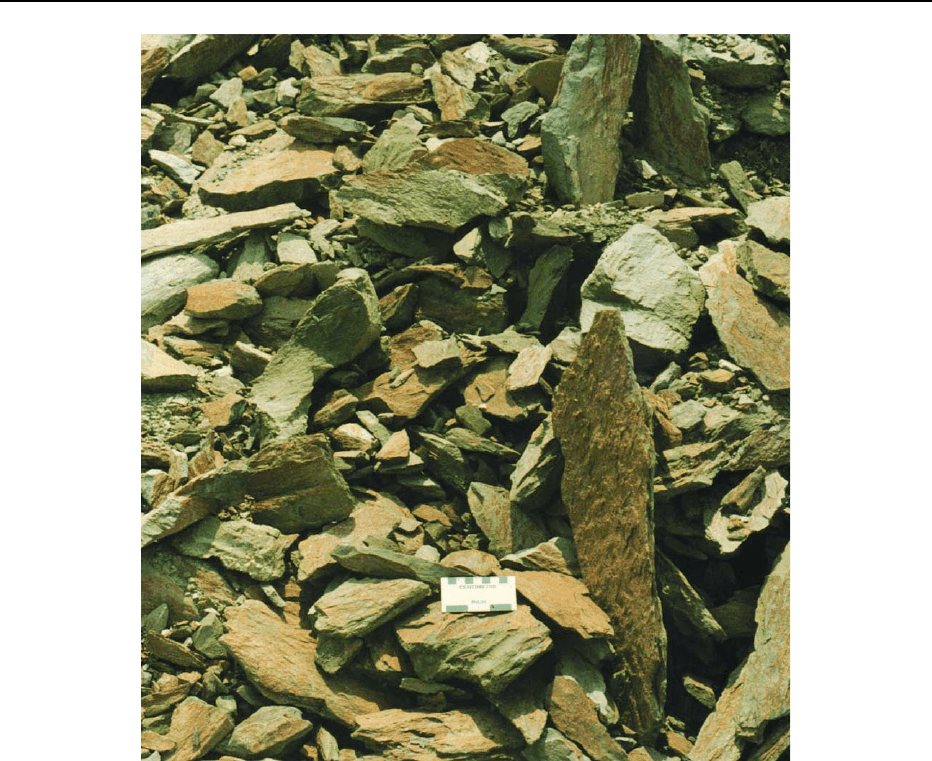Elsevier Encyclopedia of Geology - vol I A-E
Подождите немного. Документ загружается.


Site Classification
A W Hatheway, Rolla, MO and Big Arm, MT, USA
ß 2005, Elsevier Ltd. All Rights Reserved.
Introduction
Site characterization may be defined as the
...three-dimensional engineering geologic description of
the surface and subsurface of the location for intended
construction of engineered works, for habitation, com-
merce, resource development, mitigation of natural
hazards or conduct of groundwater protection, waste
management or environmental remediation.
Site characterization provides the design informa-
tion necessary for project planning. Site character-
ization is frequently broken and discontinuous in
nature, reflecting the naturally flawed ground that is
being evaluated (Figure 1). The broad elements of
site characterization are listed in Table 1. No such
table can be wholly inclusive, but it serves to estab-
lish a format for discovering and predicting the elem-
ents that should be included within the scope of
construction work.
The broad goals of site characterization include:
.
identification of sites likely to experience ground
displacement from fault movement;
.
identification of the stability of a site‘s configur-
ation;
.
establishment of the need to improve the engineer-
ing characteristics of the ground so as to resist
damaging deformation;
.
establishment of the need to control groundwater
to prevent excess pore pressure and subsequent
failure under the involved structural loads; and
.
identification of the potential for creating green
space not only for social gain but also to incorporate
active faults and existing geohazards.
Purpose and Scope of Site
Characterization
Site characterization is a major component of site
investigation, the purpose of which is to determine
ground conditions at a proposed construction site.
The current terminology signifies a broadening of the
purpose and scope to encompass the determination of
relevant design needs for a wide variety of construc-
tion, resource development, hazard mitigation, and
environmental goals.
Site investigation matured from the end of World
War II through the 1970s, and then expanded in
the 1980s, providing broad scope for the work of
engineering geologists.
There is some published guidance on site character-
ization, but it is the responsibility of the engineering
geologist in charge of each project to define the scope
of the characterization in order to meet the design
needs of the planner and engineer. These needs fall
into seven basic categories:
.
a three-dimensional description of the project site
to the depth of influence (i.e. where the maximum
applied (live and dead) static load from the
intended use of the site has dropped to 10%);
.
a description of the length and breadth of the pro-
posed site and of the area beyond the property
boundaries to such a distance as will encompass
any anticipated effect of the activities contemplated
at the site (this distance will be sufficient to cover
the origins of geological constraints that may im-
pinge on the contemplated site, including slope
instability, groundwater inundation, and loss of
ground support);
.
the identification of ground that may be affected
by displacement, volumetric change (shrinkage or
swelling), or other forms of loss of physical sup-
port or chemical integrity relating to the intended
construction;
.
the discovery or prediction of ground instability
above, below, on, or adjacent to the site;
.
the detection and measurement of groundwater
conditions (including perched and transient condi-
tions) that may affect the construction, operation,
or maintenance of the proposed works (including
the estimation of annual variations and chemical
composition, and in particular the potential to
harm human health or the environment);
.
the discovery or prediction of conditions that may
adversely affect the rate, progress, or method of
construction of the project; and
.
the detection or prediction of ground conditions
that may be unsafe or endanger the health of per-
sons engaged in construction, or in work, visitation,
or occupancy of the developed site.
Typical Site Characterization
The owner has the primary and ultimate responsibil-
ity for ordering and funding a site characterization
and for ensuring that any constraints identified by the
ENGINEERING GEOLOGY/Site Classification 1

site characterization are addressed in the design, con-
struction, operation, and maintenance of the engin-
eered works. Table 2 assesses the typical goals and
components of the site characterization of a variety of
engineered works.
Areas Subjected to Site
Characterization
In reality, no two parties engaged in planning and
conducting a site characterization will produce iden-
tical pieces of work. The quality and applicability of
every site characterization reflects the experience and
competence of its leadership. Strictly speaking, the
basic (minimal) characterization must assess the site
within the property boundaries. There are many cir-
cumstances, however, in which additional areas of
ground should be considered in order fully to address
the client‘s needs. Table 3 presents some of these
considerations.
Pitfalls of Site Characterization
There are no hard and fast rules or standards that can
be applied to all site characterizations. It is incumbent
on the engineering geologist to inform the owner of
those elements of the work that may best meet the
needs of the design engineers and the owner‘s goals
for the project.
If the owner chooses to underfund the site charac-
terization or selects characterization activities on a
price-sensitive basis, there are numerous ways in
which the end product may fail to give adequate
design-related information. Where price has not
been a determining factor in the scope of the site
Figure 1 Engineering geologists generally work with already flawed earth materials. This weak rock of Pennsylvanian age at Little
Rock, Arkansas, needs to be ripped on excavation, yet it is wholly discontinuous and platy.
2 ENGINEERING GEOLOGY/Site Classification

characterization, there are still categories of charac-
terization flaws that, if not heeded, could endanger
the achievement of design goals. Some of these are
presented in Table 4.
Conclusion
The majority of the project technical responsibilities
accorded to the engineering geologist fall under the
remit of site characterization relating to construction
and waste disposal. The aim is to ensure that properly
funded exploration and evaluation can establish
the geological information required by the design
engineers. This information is located by spatial co-
ordinates and is usually managed and displayed by
computer-assisted drawing and geographical infor-
mation systems. The geologist thereby develops a
database of usable, relevant information in the form
of colour-coded perspective drawings that are easily
assimilated by an array of (non-geoscience) pro-
fessionals who can subsequently manipulate the
data for parametric analysis or for their own better
understanding, and can do so largely without fear of
distorting the relevant facts.
Table 1 General elements of site characterization
Element Purpose Important considerations
Stratigraphy Identify and describe geological formational
units expected in design and construction
Individual engineering geological units
Groundwater regime Define character of groundwater Perched water
Vadose zone
Peizometric surface
Potentiometric surface (if present)
12 months of observation
Top of rock Define elevation or surface below which
excavation is difficult
Little’s grades of weathering will be
helpful here
Rock-mass
characterization
Delimit observable or likely subsurface
bounds of each detectable hard-rock unit
Contacts
Lithological character and variations
Geological structure represented by equal
area stereographic projection; to include
bedding or foliation attitude, discontinuities,
faults, fault zones, shear planes,
metamorphic foliation
Zones of bad ground, by virtue of alteration,
weathering, or shearing
Application of one of the standard rock-mass
qualification concepts
Presence of weak rock Basis of definition, including why the rock is
determined to be weak
Recommendations as to how and why such
weak rock may pose problems in design and/
or construction, operation, and maintenance
Potential problems related to
sedimentological, structural,
or geomorphological
conditions
Portions of surface or subsurface that may be
affected by otherwise unanticipated
features
Buried valleys
Stratigraphical ‘holidays’
Facies changes
Fault-displaced blocks of ground
Dissolution cavities (karst features)
Glacial erratics (boulders)
Irregular features of glacial and periglacial
origin
Potential instability Hillsides Unstable slope masses
River banks Subsurface mined or dissolution caverns
Ground expanse of site
Likely excavation characteristics Relative ease or difficulty of moving earth
media
Outstanding troublesome departures include
glacial, bedrock knobs at top of rock, and
some types of hard igneous intrusions such
as dykes and sills
Geological constraints Observed or postulated geological conditions
that may be known or felt to place the
project concept in jeopardy; may require
additional funds for resolution
Otherwise known as ‘geological hazards’ but
more properly known as ‘geological
constraints’ after the life work of Robert
F Legget
ENGINEERING GEOLOGY/Site Classification 3

Table 2 Elements of site characterization
Construction works Design citeria Characterization
Construction
Foundations Performance of foundation Optimal use of foundation geology to install
minimum-cost foundationStability of adjacent buildings
Stability of excavations Basements and parking spaces Basements are an economic imperative in
cities owing to the cost of landLateral cuts for building space
Recognition of groundwater
Stability of adjacent structures
Drainage and dewatering Keep excavation free of water Construction control of water versus long-
term maintenance of groundwater and
earthworks pore water
Floodworks integrity
Materials of construction Use on the project Dealing with public opposition
Export to urban areas Preservation of water quality
Land takings Provide value to owner Possible mineral resource value
Transportation
Highways and rapid transit Stable roadway Sufficient to move traffic from A to B with
minimal impact on existing infrastructureBorrow for above-ground works
Balanced cut and fill
Airfields Runway space Huge land surfaces subject to incidental
wastes from operationFuel storage
Runoff and waste management Anti-terrorist considerations
Tunnels and underground Optimal excavation method
caverns Promote ground stability Consider spoil handling and disposal, and
stability of overlying build environmentGround control
Management of groundwater
Ports and harbours Wave protection Associated dredging may disturb historic
contaminated sedimentOperational wastes
Navigable rivers Floodworks and flood control Associated dredging may disturb historic
contaminated sedimentLocks and dammed pools
Energy and resource
Dams Foundation integrity
Seismic-withstand behaviour Locate an inherently stable dam-axis
positionSlope stability
Emergency spillways Provide nearby construction materials
Pipelines Route versus geological costs Objective of minimal excavation, siphonage,
and above-ground support Anti-terrorist
considerations
Erosion protection
Seismic stability
Stability of adjacent ground
Power transmission Mainly tower stability Minimize grubbing impacts
Forest resources Slope stability Harvest the resource without diminishing
the condition of the remaining landHaul road location
Potential hydraulic damage
Mineral resources Minimize exploration damage Minimize exploration damage
Opencast Manage acid mine drainage
Underground workings Spoil management
Protection of water and soil values
Mineral beneficiation Concentrate ore value Manage soil impacts
Wastewater effluent
Reservoirs Reduce bottom leakage Requires a considered evaluation of
geomorphology and the primary and
secondary porosities of geological units in
contact with stored water
Sedimentation protection
Shoreline protection
Water quality
Groundwater recharge Use of storm waters Introduce flood and grey waters to the
groundwater regime before their loss to
oceans
Use of treated wastewater
Environmental
Waste disposal facility siting Minimize adverse impacts Control of leachate
Optimize geological conditions Protection of water quality
Locate sufficient daily cover
Water-quality protection Suspended solids Cation exchange leads to degraded water
quality (pollution), which can lead to
health effects (contamination)
Dissolved solids
Discharge into governed water
4 ENGINEERING GEOLOGY/Site Classification

Military impacts Manoeuvre and exercise grounds Vehicular disturbance of ground leads to
sedimentation
Munitions impact zones
Battle damage Spilled fuels and discharged munitions lead
to environmental degradation
Derelict land Waste dumps Ground receives contamination and surface
waters and groundwaters transport this to
human and natural-life receptors
Industrial brownfields
Abandoned mined lands
Battle damage
Environmental remediation Uncontrolled hazardous waste Characterization of site and waste is
essential to formulation of remedial
actions
Without this actual risks become
unacceptable
Saline intrusion Control freshwater withdrawal A mature art requiring only the application
of sufficient fundingSubsurface barriers
Sedimentation Soil particles Results from disturbed ground
Cation exchange Diminishes reservoir capacity when inflow
ceasesRiver and stream transport
Damages wildlife habitat by turbidity
Hazards
Flood hazards Flood channels Depends on geomorphological evidence of
past flooding, integrated with runoff
character of the related watershed
No-build zones in floodplains
Rock falls Gravitational dislodgment of rock and rock
masses above inhabited or frequented
areas
Delimit rock or masses of rock above
endangered populations or transportation
routes
Retain or devise protection from
dislodgment or trajectory impact
Snow avalanches Recurrence intervals, and conditions and
timing of recurrence
A sideline use of geological expertise in
geological-image interpretation
Seasonal advice on mitigation by
explosive intervention or shed
deflectors over railroad and
highway routes
Active faults Ground trace Dealing with vertical splaying of related fault
splays in unconsolidated units
Sense of displacement
Recurrence interval
Likely nature of strong motion Blind thrust faults as unknowns
Unstable ground Collapsing soils (water inflow) Soil properties and character make them
susceptible to damage
Expansive soils (water inflow)
Liquefaction (earthquake strong motion in
the presence of near-surface
groundwater)
Result damages foundations
Shore protection Wave-energy impact analysis Evaluation requires geomorphological
assessment in terms of the structural
character of the shore rock
Susceptibility of geological units to erosion
and toppling
Wave mitigation usually only transfers wave
energy to new targets
Volcanic Lava flows Termination or preclusion not yet possible
Ash falls Geological characterization can delimit
sources, routes, and probable areas
of impact
Pyroclastic bombs
Glowing avalanches
Mudflows (lahars) Mitigation involves avoidance or
channelization
Table 2 Continued
Construction works Design citeria Characterization
Continued
ENGINEERING GEOLOGY/Site Classification 5

Defence
Military posts and installations Characterization of ground for optimal use
in training and staging, while striving for
optimal environmental protection of
military bases
World economic situation currently favours
diminishing grounds allotted to military
forces, while increasing environmental
controls over lands used for military
training
Use of terrain Defence Trafficability
Offense Obstacles and fields of fire
River crossings
Potable water Exploration and development Alternative to use of water in the field of
operations or to importation in
competition with high-priority food
and munitions
Replacement of damaged wells and
reservoirs
Supplies for indigenous peoples and
prisoners of war
Anti-terrorism actions Defence from attack Use or exclusion of use of such features as
caves, excavated tunnels, and unstable
hillsides
Actions against terrorists
In all cases, the characterization should reflect the owner’s objectives, available funding, the normal and standing considerations for
public health, welfare and safety, and applicable and relevant regulations and codes, and should be conducted in compliance with or
with reflection on relevant codes and standards, and be completed by or under the direct supervision of a registered (chartered)
professional geologist. All specialization categories should consider the presence of geological constraints and natural hazards that
may affect the design, construction, operation, and maintenance of the project in a manner that meets the client’s objectives and
applicable national, regional, and local laws and regulations.
Table 3 Key considerations of site characterization
Construction works Key considerations Other considerations
Construction
Foundations To property boundary Adjacent ground that may be affected by the project or
have conditions that may affect the project
Stability of
excavations
Host ground to include likely active mass of
wall or face subject to possible failure
Possible adversely orientated planes or wedges of
geological weakness
Drainage and
dewatering
Maximum radius of cones of depression Search for possible hidden (geomorphological) pathways
of high hydraulic transmissibility
Materials of
construction
Secure projected quantities of acceptable
material
Locate superior materials at somewhat greater distance
Land takings Natural resource value Impact on groundwater resources
Transportation
Highways and
rapid transit
Right-of-way plus additional width affecting
existing infrastructure
Minimum of one boring or geophysical traverse for each
suspected adverse geological possibility
Minimize groundwater impact
Airfields Footprints of load-bearing areas Toxic-waste hotspots in areas of runway expansion
Tunnels and
underground
caverns
Route characterization for estimated
ground conditions
Geormorphologic and structural hazards such as
intercepted bad ground or groundwater flow pathways
Excavation
Ground support
Groundwater management
Spoil management
Ports and harbours Toxic dredge spoils Locations of toxic hotspots
Navigable rivers Lock and dam foundations Stability of caving river banks
Energy and resource
Dams Stability of embankment Consider adjacent ground hazards
Reservoirs Minimize bottom leakage Minimize incoming sediment
Groundwater
recharge
Maximize storativity Use to protect groundwater regime
Pipelines Assess geological excavation cost versus
alternative routes
Minimize environmental impact on the traversed ground
Table 2 Continued
Construction works Design citeria Characterization
6 ENGINEERING GEOLOGY/Site Classification

Power
transmission
Cost-effective tower locations Minimize impacts from unstable ground on or adjacent to
route
Forest resources Minimize hydraulic damage Minimize sediment produced
Mineral resources Minimize exploration and development
impacts
Devise safe spoil-disposal strategies and minimal cation-
exchange leaching
Mineral beneficiation Proper management of spoil Plans for plant closure
Environmental
Waste-disposal
facility siting
Isolate from groundwater Provide adequate cover sources
Water-quality
protection
Remove toxic hotspots Control entry of freshwater
Military impacts Remove explosive relics Grade land for minimal impact
Derelict land Remove toxic hotspots Control entry of freshwater
Environmental
remediation
Remove toxic hotspots Control entry of freshwater
Saline intrusion Control groundwater pumping Inject flood or treated waters
Sedimentation Reduce land disturbance Define interception features
Hazards
Flood hazards Establish likely inundation Evidence of catastrophic flooding
Rock falls Unstable rock masses Impact zones on adjacent ground
Snow avalanches Photogeological evidence of pathways Foundations and anchorage of structures to deflect snow
Active faults Establish likely rupture location Susceptibility to lateral spread or liquefaction
Unstable ground Mainly related to regional physiography Avoidance first; mitigation second
Shore protection Delimit susceptible ground Other shoreline influences, such as groundwater
seepage
Volcanic Pathway of impact Methods to deflect impact
Defence
Military posts and
installations
Footprints of structures Areas of intense use by vehicles
Use of terrain Obstacles Interdiction of enemy movement
Trafficability Neutralization of underground space
Potable water Exploration for wells Water supply basin
Anti-terrorism actions Features for approaches Unstable surrounding ground
Wellfield susceptibility to sabotage
In all cases, the characterization should reflect the owner’s objectives, the level of available funding for exploration and
characterization, and the normal geotechnical, hydrological, and environmental practices employed in the region.
Table 3 Continued
Construction works Key considerations Other considerations
Table 4 Some pitfalls of site characterization
Potential pitfall Nature
Failure to consider owner’s goals and
design conditions
Represent the stated truths of project impact on the geological environment. Owner
should be informed of the consequences of these considerations, though it is the
owner’s responsibility to act on such information
Failure to separate factual from interpreted
geological information
Discrimination should be made in order to represent the owner’s rights and position,
in which the construction contractor bears the normal risks associated with
construction under the conditions reported in the design documents and
construction specifications. Contractors are entitled to additional payments for
geological conditions not adequately defined in the contract documents. Separation
of factual from interpreted information more clearly defines the information
available for consideration by the contractor in bid formulation
Failure to apply site conceptual geological
model
Essentially a schematic drawing (cartoon) of known and possible geological
conditions at the site, superimposed on one or two (perpendicular) sketch
geotechnical profiles, from ground surface to maximum depth of expected impact
on site design
‘Geological possibilities’ It is proper to consider the possibility of certain sedimentological, stratigraphical,
structural, and geomorphological anomalies at the site, resulting from its general
regional physiographical affinity. These possibilities should be assessed in terms
of the site-development plan
Continued
ENGINEERING GEOLOGY/Site Classification 7

See Also
Engineering Geology: Codes of Practice; Aspects of
Earthquakes; Geological Maps; Natural and Anthropo-
genic Geohazards; Site and Ground Investigation; Sub-
sidence. Geological Field Mapping.
Further Reading
Anon (1970) Logging of cores for engineering purposes.
Working Party Report. Quarterly Journal of Engineering
Geology 3: 1–24.
Bell FG (1975) Site Investigations in Areas of Mining Sub-
sidence. London: Newnes-Butterworths.
Bell FG (1992) Description and classification of rock
masses. In: Bell FG (ed.) Engineering in Rock Masses,
pp. 54–77. London: Butterworths–Heinemann.
BellFG, Culshaw MG, Cripps JC, and CoffeyJR (eds.) (1990)
Field Testing in Engineering Geology. Engineering Geol-
ogySpecial PublicationNo. 6. London: Geological Society.
British Standards Institution (1999) Code of Practice on
Site Investigations, BS 5930. London: British Standards
Institution.
Cabrera JG and Hatheway AW (1991) Investigation of
preferred sites for selection and design. In: Kiersch GA
(ed.) Heritage of Engineering Geology – The First Hun-
dred Years, pp. 395–428. Centennial Special Volume 3.
Colorado: Geological Society of America.
Clayton CRI, Matthews MC, and Simons NE (1996) Site
Investigation.2ndedn.Oxford:BlackwellScienceLimited.
Craig C (ed.) (1996) Advances in Site Investigation Prac-
tice. London: Thomas Telford Press.
Culshaw MG, Bell FG, Cripps JC, and O‘Hara M (eds.)
(1987) Planning in Engineering Geology, pp. 151–154.
Regionally important geological material Failure to recognize that the subject earth material in the physiographical province
has special or unique characteristics that affect or its geotechnical behaviour
Geomorphological and structural
geological features
Failure to consider the potential for anomalous subsurface zones, pockets, or buried
valleys of materials that very significantly from those of the general host ground
Neglect to consider discontinuities Failure to recognize that discontinuities represent preformed surfaces of weakness
and therefore have the potential for displacement and sometimes groundwater or
contaminant migration
Assessment of ‘zones’ ‘Zones’ should be invoked whenever evidence suggests the existence of pockets,
bands, or other bounded bodies of earth material that could affect the design or
performance of the project. ‘Zones’ are labelled and delimited by the characterizing
engineering geologist
Deleterious minerals Ground that has been geochemically altered should be expected to potentially
produce
in situ conditions or construction material that may not perform adequately
in terms of project design. Often this occurs along the borders of intrusive bodies
Misassessment of karst Karst terrain typically shows a concentration of dissolution along major joints and at
their intersections. Much of the intervening ground may be devoid of dissolution
features of sufficient magnitude to affect the project. Use of geophysical techniques
is recommended.
Minimal time-sensitive hydrogeological
data
Only minimally accurate assessments of the character and seasonal behaviour of the
groundwater can be made with a full 12 month record of hydrogeological conditions
at and around the site
Inapplicable hydrological borehole testing A prime example is the conduct of downhole packed hydraulic conductivity testing in a
string of end-to-end positions, in which the conductivity is then averaged over the
packed interval, and sometimes over the entire tested interval, whereas the true
impact on project design and performance is more properly assigned to individual
layers or zones, which themselves should be subjected to packed testing. On
occasion this pitfall is used by litigation opposition in order to impart a condition
more favourable to the client’s interests
Belief in the ‘pristine’ brownfield
(derelict) site
All brownfield sites should be considered contaminated until shown otherwise;
brownfield sites cannot be adequately characterized for their toxic wastes without
knowledge of site technical and operational history and an understanding of the
waste-generation nature of the industrial flow path most likely to have been present
during operation
Notion of ‘non-aqueous’ phase liquids Most are toxic to people and the environment. ‘Non-aqueous’ is a chemist’s term;
these compounds have the potential to dissolve in surface water and groundwater
in concentrations inimical to health and the environment
Significance & VOCs and SVOCs Volatile organic compounds (VOCs) migrate generally and in the hydrogeological
system; semi-volatile organic compounds (SVOCs) more commonly reside at their
location of origin or dumping unless transported in sediment; SVOCs are
characteristically recalcitrant to natural or induced degradation
Table 4 Continued
Potential pitfall Nature
8 ENGINEERING GEOLOGY/Site Classification

Engineering Geology Special Publication No 4. London:
The Geological Society.
Department of the Environment (1976) Reclamation of
Derelict Land: Procedure for Locating Abandoned
Mine Shafts. London: Department of the Environment.
Griffiths JS (ed.) (2001) Land Surface Evaluation for En-
gineering Practice. Engineering Geology Special Publica-
tion No. 18. London: Geological Society.
Hatheway AW (2002) Geoenvironmental protocol for site
and waste characterization of former manufactured gas
plants; worldwide remediation challenge in semi-volatile
organic wastes. Engineering Geology 64: 317–338.
Hawkins AB (ed.) (1986) Site Investigation Practice: As-
sessing BS 5930. Engineering Geology Special Publica-
tion No. 2. London: The Geological Society.
Hempen GL and Hatheway AW (1992) Geophysical
Methods for Hazardous Waste Site Characterization.
Special Publication number 3. Lakewood CO: Associ-
ation of Engineering Geologists.
Hudson JA, Brown ET, Fairhurst C, and Hoek E (eds.)
(1993) Comprehensive Rock Engineering: Principles,
Practice and Projects. Oxford: Pergamon Press.
International Society for Testing and Materials. (1995 to
present) Various Site Characterization Standards De-
veloped by Committee D-18; Soil and Rock and Com-
mittee E-50: Environmental Assessment. West
Conshohocken, PA: International Society for Testing
and Materials
International Society for Testing and Materials (1995)
Guide to Site Characterization for Environmental Pur-
poses with Emphasis on Soil, Rock, the Vadose Zone and
Ground Water. Standard D 5730. West Conshohocken
PA: The International Society for Testing and Materials.
Lee LT, Davios WM, Goodson RA, Powell JF, and Register
BA (1994) Site characterization and analysis penetrom-
eter system (SCAPS) field investigation at the Sierra Army
Depot, Herlong, California. In: Report WES/TR/GL-94-
4, U.D. NTIS order number AD-A277887. Vicksburg,
MS: US Army Engineering and Waterways Experimental
Station.
Little AL (1969) The engineering classification of residual
tropical soils. In: Moh Z-C (ed.) Proceedings of the 7th
International Conference on Soil Mechanics and Foun-
dation Engineering: Specialty Session on Engineering
Properties of Lateritic Soils 28–29 August, 1969, Mexico
City, DF, Mexico. pp. 1–10. Bangkok, Thailand: Asian
Institute of Technology.
McCann DM, Eddleston M, Fenning PJ, and Reeves GM
(eds.) (1998) Modern Geophysics in Engineering Geol-
ogy. Engineering Geology Special Publication No. 12.
London: Geological Society.
McDowell PW, Barker RD, Butcher AP, et al. (2002) Geo-
physics in Engineering Investigations. CIRIA C562.
London: Construction Industry Research and Informa-
tion Association.
Olson O (1992) Site Characterization and Validation –
Final Report. Report STRIPA-TR-92-22, (US NTIS
order number DE93-603603). Stockholm: Swedish
Nuclear Fuel Supply Company (SKB; SvenskKaernbraen-
slefoersoerjning AB).
Sara MN (1993) Standard Handbook for Solid and Haz-
ardous Waste Facility Assessments, 2nd edn. Boca Raton,
FL: Lewis Publishers.
Sara MN (2003) Site Assessment and Remediation Hand-
book, 2nd edn. Boca Raton, FL: Lewis Publishers, CRC
Press.
Simons NE, Menzies B, and Matthews M (2002) A Short
Course in Geotechnical Site Investigation. London:
Thomas Telford Press.
Weltman AJ and Head JM (1983) Site Investigation
Manual. CIRIA Special Publication 25. London: Con-
struction Industry Research and Information Association.
Subsidence
A B Hawkins, Charlotte House, Bristol, UK
ß 2005, Elsevier Ltd. All Rights Reserved.
Introduction
Ground subsidence that results in settlement or col-
lapse of the ground surface is grouped into four main
categories: (1) subsidence due to man-made voids and
natural voids relatively close to the surface (e.g., due to
coal mining, stone mining, or karstic features), (2) sub-
sidence due to the removal of fluids from depth (e.g.,
water/oil extraction) and the consequential change in
effective stress conditions, (3) subsidence due to the
removal of soluble minerals (salt, gypsum) in ground-
water, and (4) subsidence due to the removal of fines in
suspension (piping). In addition, subsidence may occur
related to alluvial deposits, shrink/swell, volcanism,
and thermokarst.
Major Voids – Man-Made and Natural
Mining
The extraction of stone for building construction, and
coal for energy, has taken place since time imme-
morial. Early stone mining invariably extended from
adits excavated into a quarry face, either when moist
stone was required for carving and/or the overbur-
den was prohibitively thick. On the other hand, coal
mining generally extends from shafts, except where
coal seams outcrop on valley sides in areas such as
ENGINEERING GEOLOGY/Subsidence 9

South Wales. There are three main methods of mining,
long wall, pillar and room, and linear. In long-wall
mining, ground subsidence is expected, whereas in
pillar-and-room/stall mining, long-term subsidence is
considered possible. Subsidence is not anticipated in
linear mineral mining.
Long-wall mining is a relatively recent develop-
ment. Up to 80% of the horizon may be removed,
generally using machinery to win material from a
long face. During the extraction process, the roof is
supported; behind the advancing face, the roof is al-
lowed to collapse. Although some bulking will occur
as the material collapses, the depth of settlement at
the surface is commonly one-third to two-thirds the
thickness of the worked seam. Settlement is likely to
extend over a larger area than that mined because the
failure of the ground is controlled by the angle of
draw, commonly 25–45
from the vertical, depending
on the nature of the strata. This method of mining is
applicable only when the material won can be frag-
mented, and hence in Britain has been used mainly for
coal extraction and the working of the Fuller’s Earth
Bed at Bath.
p0020 Pillar-and-room/stall mining has been carried out
for many hundreds of years. It is the main method
of stone extraction and an early method of winning
coal and salt. The size and shape of the support pillars
depend very much on the nature of the material being
won and the depth of the resource. In stone mines,
the pillars may be narrower because the material is
stronger, but because it is also more brittle, failure
may occur by surface spalling. In weak materials such
as coal, salt, and gypsum, creep within the material
would be anticipated and hence the pillars are invari-
ably bigger, the height/width ratio being an important
consideration. As a consequence of the mining, the
ground above the rooms/stalls is de-stressed and spal-
ling of the roof material may occur, resulting in void
migration. Important considerations are the dimen-
sions of the rooms/stalls and the nature of the over-
lying strata. Mudrocks may experience stress-release
fissuring and spall or may act as a competent mater-
ial. Over shallow mines, despite bulking, the voids
may extend through to the surface to form a crown
hole collapse. Alternatively, the upwards migration of
the void may be intercepted by a sandstone horizon
with fewer discontinuities, with the result that the
original height/width ratio of the pillar may be greatly
changed. In this situation, the sandstone acts as a
bridge, but if overstressing of the elongated pillars
results in the collapse of one or more supports, the
adjacent columns must take the additional weight,
creating a scenario whereby larger areas may collapse
as a result of the domino effect. Typical examples
are in the Coal Measures at Bathgate, south-west of
Edinburgh, and the Heidegroeve area in the Nether-
lands, where the roof of a calcarenite mine failed in
June 1988. On both occasions, the sudden collapse of
the ground produced ‘earthquake’ shocks.
p9000In addition to the failure of the roof over pillar-and-
room workings, collapses frequently occur close to
adits and/or mine shafts where the ground experi-
ences more intense climatic change than it does deep
in the mine. Ground failure also commonly occurs
when shafts or bell pits have been inadequately filled
and/or capped.
Linear mineral mining is generally related to the
extraction of lodes of metalliferous minerals. Such
narrow workings rarely cause ground subsidence be-
cause the nature of the rock does not facilitate void
migration and the rocks are sufficiently competent
to arch over the void. However, subsidence may
occur related to old shafts, unless they have been
appropriately filled or capped.
Subsidence manifested through a particular rock
horizon may be created by failure of mining under-
taken in lower strata. Such a phenomenon is common
in the West Midlands, where the Silurian limestones
have been mined as a flux for the iron and steel indus-
try but the subsidence is seen in the overlying Coal
Measure rocks.
Mining frequently involves the necessity to drain
the strata. This may result in consolidation of the
overlying sediments and/or dissolution as ground-
water passes down to much greater depths than
would otherwise occur. The consolidation resulting
from a modification of the groundwater regime in the
area may result in structures above and adjacent to
the workings experiencing settlement. If dissolution
of cements occurs, the percolating groundwaters may
carry a fine fraction in suspension, which can again
result in settlement.
Increasingly, tunnels and other areas of under-
ground space are now being developed. During the
driving of a tunnel, the ground above the work first
experiences extension, and then, as some settlement
occurs, the stress regime changes to one of compres-
sion. Even when every attempt is made to reduce sub-
sidence and its effect on transport routes and property
above a tunnel, including the use of compensation
grouting, a settlement trough is a common feature.
Karst
Calcareous rocks are prone to dissolution by slightly
acidic water, whether the acidity is carbonic acid from
the atmosphere, humic acids from the near-surface or-
ganic-rich horizons, or sulphuric acids associated with
the weathering of iron sulphides. Although the older
limestones (such as the Carboniferous limestones),
10 ENGINEERING GEOLOGY/Subsidence
